A website without traffic is like a shop in the middle of the desert; no matter how good your product is, nobody will find it. Today, driving traffic to your website is essential for success. You need people to find you, engage with your content, and, ultimately, become loyal customers.
While traditional SEO strategies still have value, AI is revolutionizing how we approach website traffic generation. In this comprehensive guide, I’ll walk you through three simple, AI-powered steps that can help skyrocket your website traffic and turn your online presence into a lead-generating machine.
Step 1: Create a Content Plan That Drives Conversions
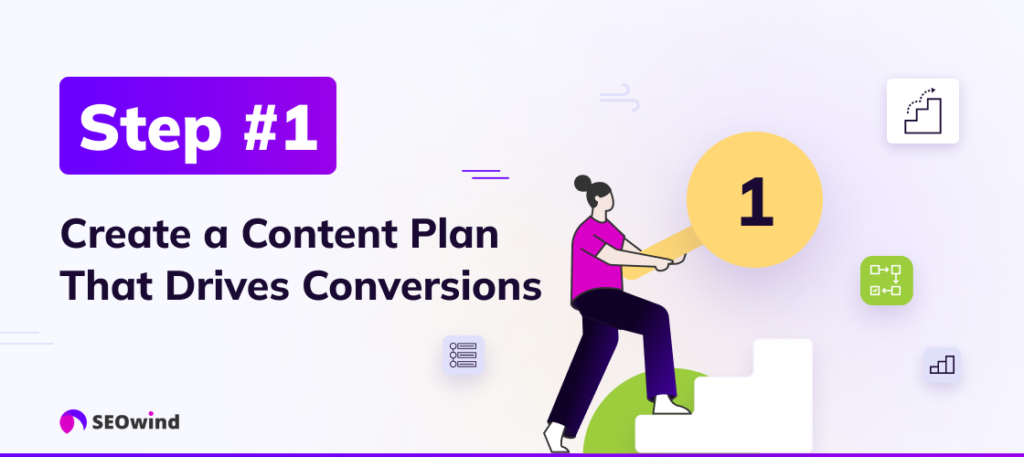
Before you even think about writing a single word, it’s crucial to have a solid content plan. This is when you’ll map out what you’ll write about and who you’re writing for. AI will help you understand your audience and competition better than ever before.
Do the Competitor Research Like Keyword Gap Analysis
Think of your competitors as your most valuable (and free!) source of market research. Keyword gap analysis helps you identify the keywords your competitors are ranking for that you aren’t. By targeting these keywords, you can capture some of that traffic for yourself.
Don’t Focus on Informational Keywords and Top Funnel Content
Informational keywords, such as “What is keyword research?” attract users who are still in the early stages of their buyer journey. Top-funnel content is designed to educate and raise awareness but doesn’t necessarily drive immediate action. Many businesses make the mistake of focusing solely on these two areas. While they have their place, they don’t always translate directly into conversions.
Go After MoFu and BoFu Keywords
Instead, prioritize middle-of-the-funnel (MoFu) and bottom-of-the-funnel (BoFu) keywords. These keywords target users who are closer to making a purchase.
For example:
- MoFu Keywords: “Motorcycle comparison,” “best car for families,” and “iPhone 14 reviews”
- BoFu Keywords: “Dog food discount,” “buy running shoes online,” “Netflix free trial”
Identify Long-Tail Keywords Relevant to Your Business
Long-tail keywords are longer, more specific phrases that people enter into search bars. While they may have lower search volume individually, they often reflect a higher purchase intent and are less competitive.
Let’s say you sell handmade jewelry. Instead of targeting a broad keyword like “necklaces,” you could focus on long-tail keywords like “sterling silver pendant necklaces for women” or “personalized birthstone necklaces for mothers.”
How SEOwind Helps Create a Content Plan
AI-powered SEO tools, like SEOwind, can streamline this entire process. SEO Missions let you conduct keyword gap analysis. This way you can analyze your competitors, identify keyword gaps, and even suggest relevant long-tail keywords. It’s like having a team of SEO experts at your fingertips!
Step 2: Create Valuable Content to Attract Traffic

Now that your content plan is ready, it’s time to roll up your sleeves and start creating. But remember, not just any content will do. You need high-quality content that caters to your audience’s needs and keeps them coming back for more.
Create High-Quality Blog Posts
A well-written blog post can do wonders for your website traffic. It’s a way to share your expertise and engage with your audience on a specific topic. When you consistently post informative and insightful blog posts, you establish yourself as a thought leader in your industry. This builds trust with your audience, which is invaluable in today’s digital landscape.
Leverage Long-form Content and Evergreen Topics
While short-form content might seem trendy, don’t underestimate the power of long-form content. In-depth articles allow you to explore topics in greater detail, providing more value to your readers. Plus, evergreen content—assets that cover topics that remain relevant over time—ensures that your pages continue to attract traffic long after their initial publication. It’s a gift that keeps on giving.
Develop Comprehensive Guides and How-to Articles
People often turn to the internet for guidance. By creating comprehensive guides and how-to articles, you’re providing practical solutions to your audience’s pain points. When you offer genuinely helpful content that empowers your readers, you increase their likelihood of returning to your website for more.
Use Case Studies and Success Stories
If you want to build credibility and trust, I recommend showcasing your expertise with compelling case studies and success stories. Real-life examples resonate with your audience, demonstrating how your product or service has helped others achieve positive outcomes. When you share these stories effectively, you provide social proof and inspire potential customers.
Use the CyborgMethod™
Speaking of success stories, let me share one with you. By using SEOwind’s AI-powered features and the CyborgMethod, I achieved a remarkable 560% growth in organic traffic for a client.
This approach combines the power of AI with human expertise, resulting in high-quality content optimized for search engines. Imagine what you could achieve by integrating this method into your content creation process.
How SEOwind Helps with Creating Helpful Content
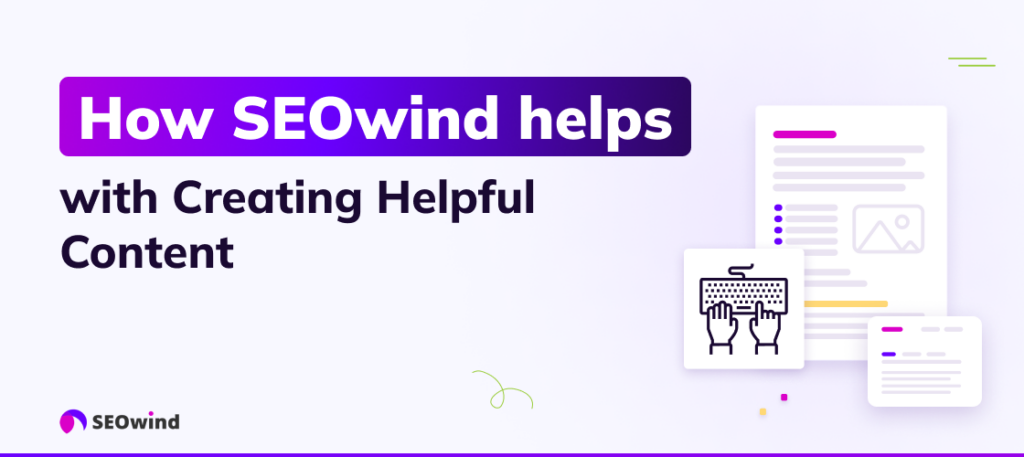
SEOwind is a powerful AI-driven content creation tool that empowers businesses to generate large-scale, SEO-optimized content. By leveraging advanced algorithms and data-driven insights, SEOwind streamlines the content creation, ensuring that your articles and blog posts are engaging and designed to drive organic traffic and conversions.
Conduct In-depth Content and Keyword Research
First, SEOwind thoroughly analyzes the data you provide to conduct comprehensive content and keyword research. The tool identifies relevant keywords and analyzes your competitors to understand what’s already working as well as gaps in their content that you can exploit.
Create an Outline Based on Data
With the insights gathered from the content and keyword research, SEOwind generates a detailed content outline that serves as a roadmap for your article. This outline is based on data-driven best practices, ensuring that your content is well-structured, covers all the essential points, and follows a logical flow. By using an outline based on data, you can be confident that your content is optimized for both search engines and reader engagement.
Add Relevant User Queries (Quora, Reddit, Google)
Here’s where SEOwind gets really smart. It scours the web, collecting relevant user queries from platforms like Quora, Reddit, and Google. Why is this a game-changer? Because it ensures you’re addressing the actual questions and concerns your audience has, increasing the chances of your content resonating and ranking well.
Add Your Insights
Now, it’s time for you to sprinkle in your personal expertise. SEOwind lets you seamlessly integrate your own insights, experience, and data into the AI-generated content. After all, you’re the expert in your field, and your unique perspective will make your content stand out.
Write with your brand voice
Consistency in brand voice is crucial for building trust and recognition with your audience. SEOwind allows you to define your brand’s tone of voice, ensuring that all the content generated aligns with your brand’s personality and values. By feeding the AI with your brand guidelines, you can maintain a cohesive and authentic voice across all your content, strengthening your brand identity and connection with your readers.
Add Relevant Stats and Quotes
To further enhance the credibility and impact of your content, SEOwind helps you incorporate relevant statistics and quotes from reputable sources. For example, according to a recent study, “Nearly 2 in 3 websites have an average bounce rate under 40%, and just 11% of websites have an average bounce rate over 60%.” By including such data-driven insights, you can support your arguments, provide context, and make your content more persuasive and trustworthy.
Add Internal Links to the Article Automatically
Internal linking is a crucial aspect of on-page SEO, as it helps search engines understand your website’s structure and relevance. SEOwind simplifies this process by automatically adding relevant internal links to your articles. By integrating with Google Search Console (GSC), SEOwind analyzes your existing content and suggests appropriate internal links, ensuring that your website has a well-organized structure and that users can easily navigate between related articles.
Step 3: Content Update with AI
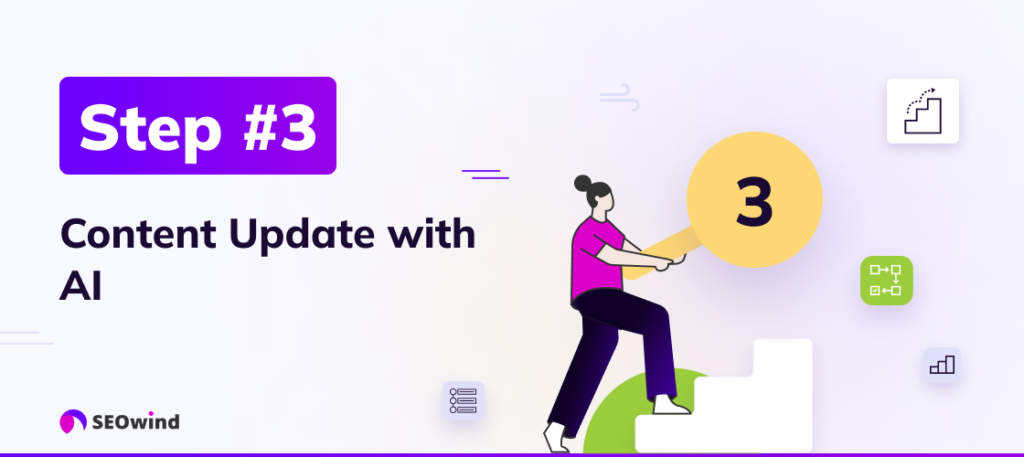
Let’s say you already have a dozen articles on your blog and followed all the earlier advice. You performed in-depth content research and have a good understanding of your audience. But you still don’t get the results you want. What can you do?
Before you start panicking, let me tell you that content marketing is a marathon, not a sprint. It takes time to see results. But, if you’re patient and consistent, you will eventually see your website traffic grow.
AI can help you accelerate this process and breathe new life into your existing content. Here’s how.
Updating Content with AI: My Step-by-Step Guide
Updating content with AI tools like SEOwind can significantly enhance your content’s performance. Here’s a detailed process to help you get started and achieve fantastic results:
Step 1: Create a Brief in SEOwind
Begin by selecting a keyword relevant to your content. For instance, let’s use “growing blueberries in pots.” Use SEOwind to create a brief for this keyword.
Step 2: Generate a Comprehensive Outline
Use SEOwind’s “Get AI Outline” feature to quickly generate a detailed outline. This will serve as the backbone of your updated content.
Step 3: Add Missing Headings
Review the AI-generated outline and compare it with your current article. Add any headings from the AI outline missing in your existing content.
Step 4: Regenerate the AI Outline
To ensure you haven’t missed anything, regenerate the AI outline. This step helps you cover all essential points.
Step 5: Analyze Competitors
Examine top-performing pages for your chosen keyword. Identify and incorporate valuable ideas and headings from these pages into your outline.
Step 6: Review Questions to Answer
SEOwind provides a list of questions your content should answer. Ensure these questions are included in your outline to cover all potential reader inquiries.
Step 7: Incorporate Secondary Keywords
Fill in your outline with relevant secondary keywords to enhance SEO performance.
Step 8: Generate AI Article
Use SEOwind to generate an AI-written article based on your comprehensive outline. The AI will create SEO-optimized content that aligns with your tone of voice.
Step 9: Review and Edit AI Content
Carefully review the AI-generated content. Make necessary edits to add a personal touch and ensure the content aligns with your brand voice.
Step 10: Publish and Re-index
Add the updated content to your article and publish it. For maximum visibility, use Google Search Console to re-index the updated page.
Pro Tips:
- Continuous Monitoring: Regularly monitor your content’s performance and update as needed.
- Engage with Readers: Encourage readers to comment and share your updated content to increase engagement.
By following these steps, you can effectively update your content with AI, ensuring it remains relevant, comprehensive, and optimized for search engines.
On-page SEO Best Practices
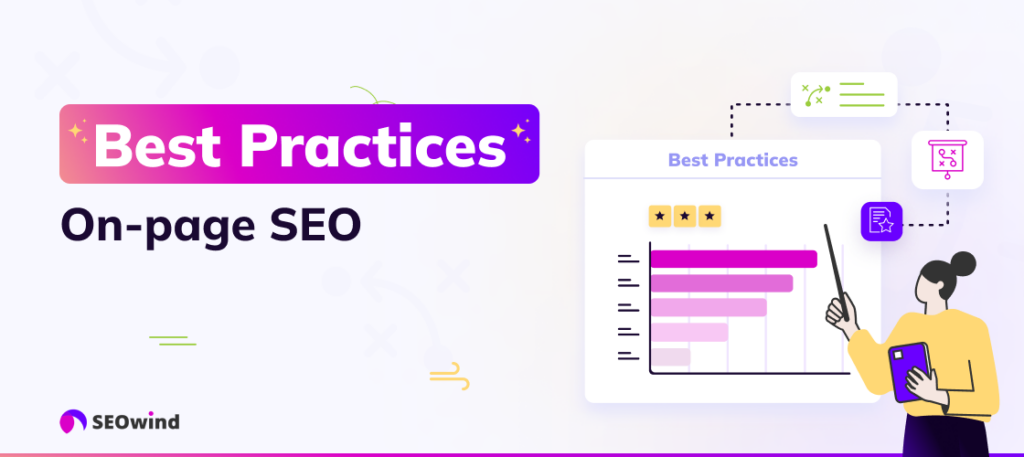
On-page SEO plays a vital role in attracting organic traffic to your website.
AI tools can help with on-page SEO:
- Keyword research and optimization: AI-powered tools can analyze large amounts of data to identify your website’s most relevant and high-traffic keywords. They can also help optimize the placement and density of these keywords within your content.
- Content creation and optimization: AI tools can help generate high-quality, SEO-friendly content by analyzing top-ranking pages and providing suggestions for topics, structure, and length. They can also create content briefs or outlines to guide your writing process.
- Meta tags and descriptions: AI can help create compelling, keyword-rich meta titles and descriptions that improve click-through rates from search engine results pages (SERPs).
- Image optimization: AI tools can analyze images and suggest appropriate alt tags, captions, and file names to improve their visibility in image search results and contribute to overall on-page SEO.
- Internal linking and site structure: AI can analyze your website’s structure and suggest internal linking opportunities to improve navigation, distribute link equity, and boost the relevance of your pages for specific keywords.
This will save you time, improve the quality and relevance of your content, and ultimately drive more organic traffic to your website.
AI tools for On-page SEO
Here are three AI tools that can help with on-page SEO best practices:
- SEOwind: This tool analyzes top-ranking pages for a keyword and delivers detailed content and keyword analysis. It also lets you create an AI meta title, AI meta description, and AI outline with matching secondary keywords. Thanks to its integration with Google Search Console, it automatically adds internal links.
- Surfer SEO: This tool uses artificial intelligence to analyze the top-ranking pages for a given keyword and provides recommendations for optimizing your content. It offers suggestions for keyword density, word count, headings, images, and other on-page elements to help you create content that is more likely to rank well in search engines.
- MarketMuse: This AI-powered platform helps you optimize your content for better search engine rankings by analyzing your content and providing recommendations for improvement. It uses natural language processing and machine learning to identify gaps in your content, suggest relevant topics and keywords, and help you create more comprehensive and authoritative content.
Technical SEO Essentials
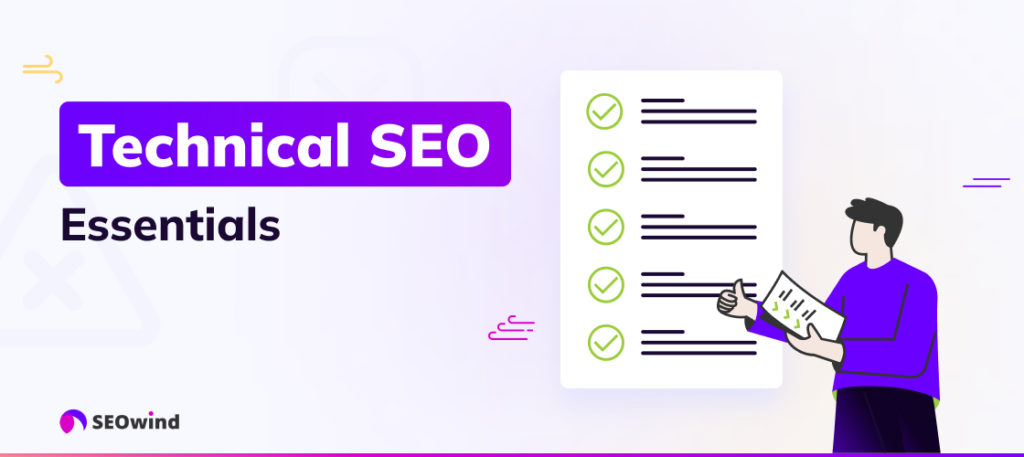
In addition to on-page SEO, technical SEO factors are crucial in driving website traffic. AI can assist in identifying and resolving technical issues that may hinder your website’s performance.
AI tools can assist with various aspects of Technical SEO Essentials like:
- Site Crawling and Indexing: AI-powered tools can efficiently crawl and analyze websites, identifying potential issues hindering search engine crawlers from properly indexing the site. These tools can detect broken links, duplicate content, and other technical problems, providing actionable insights for optimization.
- Page Speed Optimization: AI algorithms can analyze website performance metrics and provide recommendations to improve page load times. They can identify resource-heavy elements, such as large images or unoptimized code, and suggest optimizations to enhance the user experience and improve search engine rankings.
- Structured Data Implementation: AI tools can help implement and validate structured data markup, such as schema.org. They can automatically generate and test structured data, ensuring it is correctly formatted and aligned with search engine guidelines. This can enhance the visibility of rich snippets in search results and improve click-through rates.
- Mobile Optimization: AI can assess a website’s mobile-friendliness, identifying issues related to responsive design, touch elements, and mobile usability. It can then provide recommendations to optimize the mobile experience, such as improving touch target sizes, minimizing pop-ups, and ensuring proper viewport configuration.
- Log File Analysis: AI algorithms can analyze website log files to understand how search engine bots interact with the site. They can identify crawl errors, monitor bot behavior, and detect unusual patterns or issues. This analysis helps optimize the site’s architecture, resolve crawl budget issues, and properly index important pages.
Building Internal Links Effectively
Internal linking is a powerful technique for improving your website’s structure, navigation, and search engine visibility. AI can revolutionize the way you build internal links within your content. AI algorithms can suggest relevant internal linking opportunities by analyzing your website’s existing content and understanding the semantic relationships between different pages.
Let’s look at various aspects AI tools can help you with when dealing with internal links:
- Identifying relevant content: AI-powered tools can analyze your website’s content and identify pages that are semantically related or cover similar topics. This helps you find opportunities to create relevant internal links between pages, improving user navigation and search engine crawlability.
- Suggesting anchor text: AI algorithms can suggest appropriate anchor text for your internal links based on the content of the source and target pages. This ensures that the anchor text is relevant and descriptive and helps search engines understand the context of the linked pages.
- Optimizing link placement: AI tools can analyze user behavior and engagement metrics to determine the most effective placement for internal links. By considering factors such as click-through rates and user flow, AI can recommend optimal locations for internal links to maximize their impact on user experience and SEO.
- Detecting broken links: AI-powered tools can regularly scan your website to identify broken internal links. By promptly detecting and fixing broken links, you can maintain a seamless user experience and avoid potential negative impacts on search engine rankings.
- Monitoring and reporting: AI tools can provide comprehensive reports on your website’s internal linking structure, including metrics such as the number of internal links, the distribution of links across pages, and the effectiveness of your internal linking strategy. These insights help you make data-driven decisions and continuously optimize your internal linking efforts.
By establishing a well-structured internal linking network, you can guide users to related content, keep them engaged on your website, and distribute link equity effectively.
AI tools for Building Internal Links Effectively
Here are 4 AI tools that can help with building internal links effectively:
- Ahrefs: Ahrefs is an all-in-one SEO tool that offers a variety of features, including an internal linking tool. This tool analyzes your website’s structure and suggests relevant internal linking opportunities to improve your site’s navigation and SEO performance.
- Semrush: Semrush is another popular SEO tool with an internal link feature. It identifies highly authoritative pages and suggests linking them to other relevant pages on your site to distribute link equity and boost overall SEO.
- SEOwind, for instance, can automatically add contextually relevant internal links to your articles by analyzing your content and data from Google and Google Search Console (GSC). This ensures your internal linking strategy is data-driven and aligns with your overall SEO objectives.
- InLinks: InLinks is an AI-powered content optimization platform that improves internal linking. It analyzes your content and automatically suggests internal links to relevant pages, making creating a well-structured, interconnected website easier.
Utilizing Structured Data and Rich Snippets
Structured data and rich snippets are valuable tools for enhancing your website’s visibility in search results. By marking up your content with schema.org vocabulary, you can provide search engines with additional context about your pages, such as product information, reviews, events, etc. AI can automate your website’s structured data implementation process, ensuring accuracy and consistency.
Furthermore, AI can analyze your content and suggest opportunities for leveraging rich snippets, such as featured snippets, carousels, and knowledge panels. By optimizing your content for these enhanced search features, you can increase your website’s visibility, attract more clicks, and drive targeted traffic to your pages.


